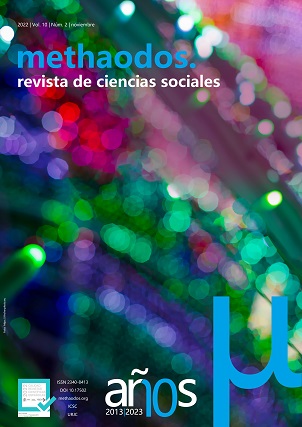Smarts cities: An anthropological challenge
Main Article Content
Abstract
The Smart City is a response to the challenges that humanity is facing. In this new urban concept, interrelationships are intensified. These densely populated urban settings approach the security challenge in a very different way than the Roman civitas. While in the Smarts Cities security structures are generated based on video surveillance artefacts and commercialized services, the civitas focuses on the feeling of security that is culturally constructed between the person and their community.In this article we analyse from a holistic perspective the anthropological challenge of living in Smarts Cities, based on the complex chronotope that determines our lives and the universal modules of culture, which facilitate its cultural interpretation, assuming that security is a universal aspiration of humanity. This analysis leads us to conclude that security in the Smart City is based on the use of data managed in Data Centres and the Artificial Intelligence algorithms that classify and apply them. The inhabitants of these technological cities will base their security on the data reported by the digital devices that surround them and they will confuse, regarding security, the structure with the feeling of it.
Downloads
Article Details

This work is licensed under a Creative Commons Attribution-NonCommercial 4.0 International License.
References
Álvarez Munárriz, L. (2011). La categoría de Paisaje cultural, AIBR. Revista de Antropología Iberoamericana, 6(1), 57-80. https://www.redalyc.org/articulo.oa?id=62321332004
Antón Hurtado, F. (2012). Antropología del Sinsentido, Revista de Antropología Experimental, 12, 349-371. http://www.ujaen.es/huesped/rae/articulos2012/27anton12.pdf
Antón Hurtado, F. y Ercolani, G. (2015). Antropología de la seguridad: de la estructura al sentimiento. Cultura y Conciencia, Revista de Antropología, 1, 31-53. https://bit.ly/3V7UiwT
Augé, M. (2008). Los no lugares, espacio del anonimato: una antropología de la sobremodernidad. Gedisa.
Baños Boncompain, A. (2012). Posteconomía. Hacia un capitalismo feudal. Los libros del lince.
Beck, U. (1992). Risk Society: Towards a New Modernity. SAGE.
BOE (1997, 5 de agosto). Ley orgánica 4/1997, de 4 de agosto. Boletin Oficial del Estado (186). Reglamento (UE) 2016/679 del Parlamento Europeo y del Consejo, de 27 de abril de 2016 relativo a la protección de las personas físicas en lo que respecta al tratamiento de datos personales y a la libre circulación de estos datos y por el que se deroga la Directiva 95/46/CE (Reglamento general de protección de datos).
Cabezas, I. (2021). Moore, Butter, Kryder y Kurzweil. Las leyes de la 4ª revolución industrial, https://bit.ly/3T15XM2
Carracedo, J.D., (2002). La vigilancia en las sociedades de la información. ¿Un panóptico electrónico?, Política y Sociedad, 39(2), pp. 437-455.
Centro de Investigaciones Sociológicas (CIS). (2013). Barómetro de mayo: distribuciones marginales, estudios nº 2.972 y nº 2.987.
Calonge Reíllo, F. (2012). La ciudad como colectivo ético. Una propuesta post-humanista de análisis, Daímon. Revista Internacional de Filosofía, 55, 57-71.
Durán Alonso, S., y Aranda Serna, F.J. (2021). Videovigilancia en lugares públicos: su utilización como prueba en el proceso penal español. Estudios en Seguridad y Defensa, 16(31), 115-135. https://doi.org/10.25062/1900-8325.298
Ellen, R. (2010). Theories in anthropology and “anthropological theory, Journal of the Royal Anthropological Institute, 16.
Fernández Alba, A. (2018). Locus Civitatis. Escritos metropolitanos y otras afinidades. Ediciones de la Universidad de Salamanca.
Foucault, M. (2009). Vigilar y castigar. Siglo veintiuno
Harari, N.Y. (2018). 21 lecciones para el siglo XXI. Debate.
Harari, N.Y. (2014). Sapiens: de animales a dioses. Debate.
Harvey, D. (2011). The enigma of capital and the crisis of capitalism. Oxford. Oxford University Press.
Healy, S., y Braithwaite, V. (2000). Cognitive ecology: a field of substance?, Trends in Ecology & Evololution, 15.
Klein, N. (2007). La doctrina del shock: el auge del capitalismo del desastre. Paidós.
Kurzweil, R. (1999). La era de las máquinas espirituales. Cuando los ordenadores superen la mente humana. Planeta.
Lévi-Strauss, C. (2011). L’anthropologie face aux problèmes du monde modern. Seuil.
Linton, R. (1942). Estudio del hombre. FCE.
Loukaitou-Sideris, A., y Banerjee, T. (1998). Urban Design Dowtown: Poetics and Politicis of Form. University of California Press.
Lyotard, J.F. (2008). La condición postmoderna: informe sobre el saber. Cátedra.
Norris, C., y Armstrong, G. (1999). CCTV and the social structuring of surveillance. Crime Prevention Studies, 10, 157-178.
Puértolas, A. (2022). Un millón de ojos te observan cada día: quién está detrás de estas cámaras y cómo te afecta su vigilancia. https://bit.ly/3Ekquam
Riveiro Sambad, A. (2020). Los amos de la humanidad: doctrina neoliberal, hegemonía corporativa y el capitalismo del COVID-19. https://bit.ly/3T0WgNJ
Ruiz Chasco, S. (2014). Videovigilancia en el centro de Madrid: ¿Hacia el panóptico electrónico? Revista Teknokultura, 11(2), 301-327. http://teknokultura.net/index.php/tk/pages/view/opr-226
The Economist Intelligence Unit Limited. (2018). Smart Cities: investing in the future. https://bit.ly/3T2GsKd
White, L. (1982). La ciencia de la cultura: Un estudio sobre el hombre y la civilización. Paidós.

